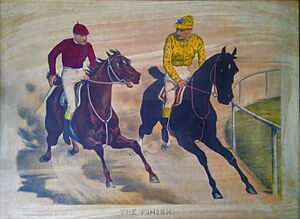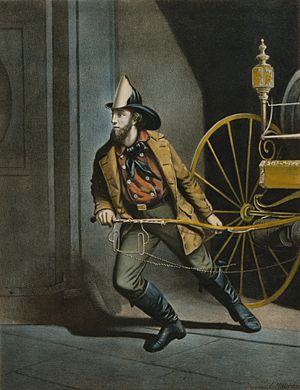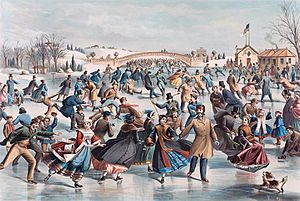Currier and Ives facts for kids
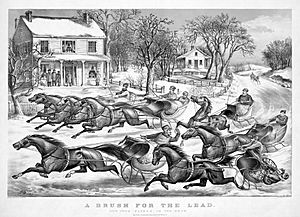
Currier and Ives was a famous printmaking company in New York City. It operated from 1835 to 1907. The company was started by Nathaniel Currier. They made and sold affordable, hand-painted lithographs. These prints showed news events, popular culture, and scenes of American life. They called themselves "the Grand Central Depot for Cheap and Popular Prints." In 1857, the company's name changed to "Currier and Ives" when James Merritt Ives joined as a partner.
One very popular series of prints they made was called the Darktown Comics lithographs.
Contents
History of the Company
Nathaniel Currier's Early Life
Nathaniel Currier (1813–1888) was born in Roxbury, Massachusetts, on March 27, 1813. He was the second of four children. His family lived a simple life. When Nathaniel was eight years old, his father died. Nathaniel and his older brother Lorenzo had to help support their mother and younger siblings.
Nathaniel did many small jobs to help his family. At age fifteen, he began his career by becoming an apprentice at a lithography shop in Boston. In 1833, when he was twenty, he moved to Philadelphia. He did work for M.E.D. Brown, a well-known engraver and printer. Nathaniel's first lithographs were made with a partner named Stodart in New York. They focused on "job" printing, like music sheets. Currier was not happy with the money they made, so he ended the partnership in 1835. He then started his own business called "N. Currier, Lithographer."
Currier's Rise to Fame
In 1835, Nathaniel Currier made a lithograph showing a big fire in New York City. This print of the Merchant's Exchange building sold thousands of copies in just four days. Currier realized that people wanted prints about current news. He then made more prints about disasters and other local and national events. For example, he made a print about the collapse of the Planter's Hotel in New Orleans.
He quickly became known as a skilled lithographer. In 1840, he created "Awful Conflagration of the Steam Boat Lexington" which was very popular. It was so successful that he got a weekly spot in New York Sun newspaper. Around this time, Currier's company started focusing more on publishing its own prints instead of just doing printing jobs for others.
Partnership with James Merritt Ives
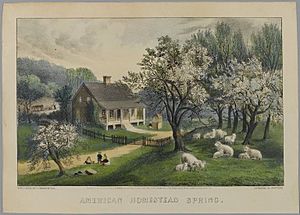
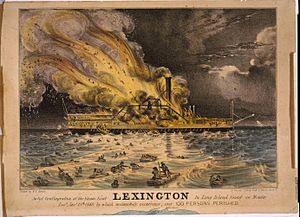
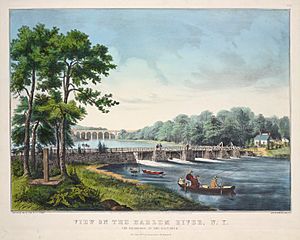
The name Currier and Ives first appeared in 1857. This was when Nathaniel Currier invited James Merritt Ives (1824–1895) to become his partner. Ives was the company's bookkeeper and accountant. He was born on March 5, 1824, in New York City. James Ives was recommended to Nathaniel by Nathaniel's brother, Charles Currier.
Nathaniel Currier soon noticed Ives's hard work and his good understanding of what people wanted to buy. Ives quickly became the general manager. He updated the company's financial records and organized their inventory. He also helped make the printing process smoother. Ives helped Currier choose artists and decide which images the company would publish. He was good at guessing what would be popular. He helped expand the company's prints to include funny political pictures and heartwarming scenes. These included sleigh rides in the country and steamboat races. In 1857, Currier made Ives a full partner.
The Currier and Ives Company
What They Published
The Currier and Ives company called itself "Publishers of Cheap and Popular Prints." They published at least 7,500 different lithographs during their 72 years of business. Artists created two to three new images every week for 64 years (1834–1895). They produced over a million prints, all hand-colored.
Currier and Ives worked with many famous artists of their time. Some of these included James E. Buttersworth, George Inness, and Thomas Nast. Key artists for the company were Arthur Fitzwilliam Tait, who drew sports scenes, and Louis Maurer, who drew everyday life scenes. George Henry Durrie provided winter scenes. Frances Flora Bond Palmer drew beautiful American landscapes. She was the first woman in the United States to earn a living as a full-time artist.
How Prints Were Made
All lithographs were made using lithographic limestone printing plates. The drawing was done by hand on these stones. It often took over a week to prepare a stone for printing. Each print was then pulled by hand. After printing, the prints were hand-colored by many women, often immigrants from Germany. They worked like an assembly line, with each worker adding one color. They were paid $6 for every 100 colored prints. The colors used were usually bright and simple, and the drawings were bold.
The first lithographs were printed in black and then colored by hand. As new methods developed, they started making full-color lithographs. These new prints had softer, more painterly effects. Skilled artists like John Cameron and Fanny Palmer became known for their work and signed important pieces. Artists like A. F. Tait became famous when their paintings were made into lithographs.
Popularity and Sales
Currier and Ives was the most successful lithography company in the U.S. Their prints showed all parts of American life. Topics included hunting, fishing, city life, country scenes, historical events, clipper ships, yachts, steamships, railroads, politics, and winter scenes.
From 1866, the company had three floors in a building in New York:
- The third floor had hand-operated printing presses.
- Artists, stone grinders, and lithographers worked on the fourth floor.
- Colorists worked on the fifth floor.
Small prints sold for five to twenty cents each. Larger prints sold for $1 to $3. Currier and Ives sold prints from their main shop in New York City. They also sold them through street vendors, peddlers, and bookstores. They sold both retail and wholesale. They had stores in cities across the country and in London. They also sold prints by mail and internationally through an office in London.
People in the 1800s loved the company's prints. They were interested in current events and enjoyed sentimental art. Currier and Ives prints were very popular decorations for homes. In 1872, the company proudly stated that their prints were "in great demand in every part of the country."
Nathaniel Currier died in 1888. James Ives continued to work in the company until his death in 1895. The sons of both Currier and Ives continued the business. However, the company eventually closed in 1907. This was because new printing methods like offset printing and photoengraving became popular. These new methods made lithographs less in demand.
Currier and Ives is even mentioned in the popular Christmas Carol Sleigh Ride.
The Lithographs
The prints showed many different images of American life. These included winter scenes, horse-racing images, portraits of people, and pictures of ships. They also showed sporting events, patriotic scenes, and historical events. These included battles of the American Civil War, the building of cities and railroads, and Lincoln's assassination.
Problematic Prints
Currier and Ives also made many prints that were racist. These were especially in a series called the Darktown Comics. These prints showed African Americans in very disrespectful ways. They made fun of them to white audiences. These types of images were unfortunately popular in the 1800s and were in high demand. Many of these images can still be seen and bought today.
Because Currier and Ives aimed to sell to middle-class Americans, their prints show what people valued in the United States in the 1800s. This included the racism of the time. Of about 500 "comic prints" made by Currier and Ives, more than half were the "Darktown Comics." Their humor came from making fun of people in a very exaggerated way. The Darktown Comics series was one of Currier and Ives's bestsellers. One print sold 73,000 copies.
Print Characteristics and Collecting Today
Original lithographs from Currier and Ives had similar ink and paper. They also came in standard sizes (trade cards, very small, small, medium, large). These sizes did not include the title or borders. Today, these sizes help collectors tell if a print is an original. Currier used cotton-based paper until the late 1860s. After 1870, they used paper mixed with a small amount of wood pulp. Also, Currier's inking process had a unique look with elongated splotches and dashes of ink. Modern copies do not have this feature.
In 1907, the company closed. Most of the lithographic stones had their images removed and were sold. Some even ended up as landfill in Central Park. Only a few stones survived with their images intact. These included large Clipper Ships, small Darktown Comics, a medium "Abraham Lincoln," and a small "Washington As A Mason."
Today, original Currier and Ives prints are highly sought after by collectors. Modern copies are also popular decorations. The winter scenes are especially popular and are often used for American Christmas cards. In 2019, a print called Across the Continent by Fanny Palmer sold for over US$60,000 at an auction.
Images for kids
See also
 In Spanish: Currier & Ives para niños
In Spanish: Currier & Ives para niños


